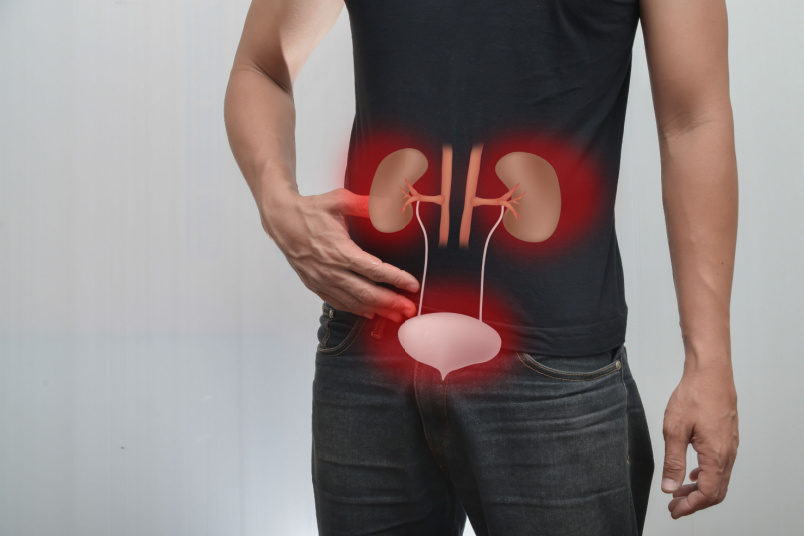The prostate gland, resembling a walnut in size and shape, is a small organ found in men. Its primary role is to produce fluid for semen, facilitating the transportation of sperm.
Prostate cancer is a type of cancerous growth that typically originates in the outer region of the prostate. As the tumour progresses, it can extend to the inner part of the prostate and even spread to other areas of the body. During the initial stages, prostate cancer does not exhibit any noticeable symptoms. However, as the tumour grows, it can exert pressure on the urethra, leading to urinary difficulties.
Implications of prostate cancer on kidney health

As prostate cancer progresses, it becomes more common for the cancer to spread from the prostate to the urethra. This can cause a complete blockage of the urethra, making it difficult to pass urine. When the urethra is blocked, it can lead to a condition called hydronephrosis, where urine backs up into the bladder, ureters, and kidneys, resulting in kidney swelling. If both ureters are blocked, it can lead to kidney failure. Typically, kidney failure starts slowly and may not exhibit symptoms in the early stages.
Is it possible for prostate cancer to result in kidney cancer?
Metastatic prostate cancer occurs when cancer cells from the tumour break away and travel through the bloodstream or lymph system to other parts of the body. It is extremely rare for prostate cancer to spread to the kidneys. However, it is more common for the cancer to spread to the bones, distant lymph nodes, liver, and lungs. Prostate cancer metastasizing to distant organs typically occurs when the cancer has already grown significantly.
Symptoms that may occur before cancer spreads to distant parts of the body include:
- Weak stream of urine
- Frequent urination
- Urinary incontinence
Metastasis of prostate cancer
Prostate cancer can spread to both local and distant regions. In cases where the treatment proves ineffective, the cancer can still metastasize to these areas.
Local spread commonly occurs in:
- Seminal vesicles
- Bladder
- Rectum
- Proximal lymph nodes
- Urethra
Bones, liver, lungs, and distant lymph nodes are the most commonly affected areas when prostate cancer spreads to distant regions. Malignant prostate cells have a higher tendency to spread to the bone due to the affinity between bone marrow endothelial cells and prostate cancer cells.
The types of cancers that have a higher tendency to metastasize to the kidneys include lung cancer, breast cancer, stomach cancer, oesophageal cancer, and colon cancer.
Signs that suggest the spread of prostate cancer
The symptoms of metastatic prostate cancer depend upon the location of its spread within the body. Initially, most people remain asymptomatic.
In the event that the cancer metastasizes to the kidneys, it has the potential to impact either one or both of these vital organs. Common symptoms include:
- Flank pain
- Blood in urine
- Weight loss
- Sweating
- Fever
The accumulation of waste in your bloodstream can lead to various symptoms, including:
- Fatigue
- A sense of overall illness
- Oedema (swelling) in your ankles and feet
- Decreased appetite
Stage 4 prostate cancer can also exhibit other symptoms, such as:
- Unexplained weight loss
- Lack of energy
- Reduced physical strength
- Pain in the bones or increased susceptibility to fractures
- Swelling in the abdominal region
- Yellowing of the skin and eyes (jaundice)
- Headaches, dizziness, and seizures, if the cancer has metastasized to the brain
Treatment for metastatic prostate cancer
Treatment for advanced or metastatic prostate cancer aims to decrease the size of the tumour, manage its growth, and alleviate associated symptoms. Treatment options include:
Hormone therapy: Hormone therapy plays a crucial role in the management of metastatic prostate cancer. Its primary objective is to inhibit the synthesis of androgens, which are responsible for stimulating the growth of prostate cancer cells. The commonly prescribed medications for this purpose are luteinizing hormone-releasing hormone (LHRH) agonists, antagonists, and anti-androgens. Although these treatments are initially successful, the development of resistance over time may require the implementation of additional therapeutic approaches.
Chemotherapy: Chemotherapy drugs specifically target cancer cells that are dividing rapidly. This method offers a comprehensive treatment to combat cancer cells throughout the entire body, and it can prove especially advantageous in symptom management and prolonging survival.
Immunotherapy: Immunotherapy is used to strengthen the immune system's response to cancer cells.
Radiation therapy: Radiation therapy can be used to focus on particular regions where the cancer has metastasized, to provide relief from symptoms like pain or obstruction. Stereotactic body radiation therapy (SBRT) is a precise radiation technique that targets the tumour, while minimizing harm to the surrounding tissues.
Bone-targeted therapies: Bone-targeted agents play a significant role in strengthening bones, alleviating pain, and reducing the occurrence of skeletal-related events. These drugs greatly contribute to enhancing the quality of life for patients with cancer that has metastasized to the bones.
Urethral blockage caused by metastatic prostate cancer The treatment landscape for metastatic prostate cancer is constantly evolving, necessitating a personalized approach that considers factors such as age, overall health, and genetic markers. Treatments including hormone therapy, chemotherapy, immunotherapy, targeted therapies, radiation, bone-targeted agents, etc. can be used to optimize outcomes for individuals with metastatic prostate cancer.
NU Hospitals, located in Bangalore, India, is a renowned hospital that focuses on nephrology and urology. With its cutting-edge facilities and advanced technology, it delivers exceptional medical care for the treatment of prostate cancer.
Author: Dr. Nagarjuna Reddy

